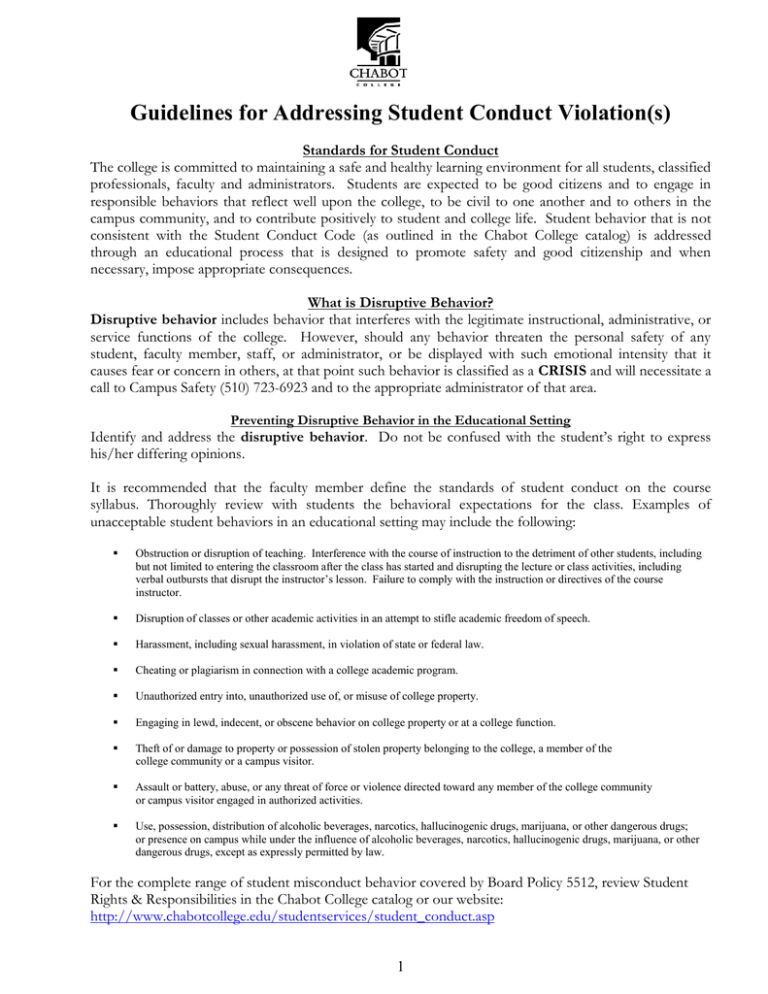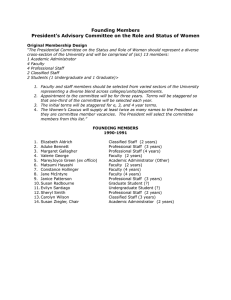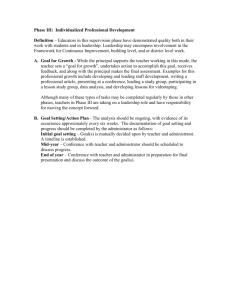Guidelines for Addressing Student Conduct Violation(s)
advertisement

Guidelines for Addressing Student Conduct Violation(s) Standards for Student Conduct The college is committed to maintaining a safe and healthy learning environment for all students, classified professionals, faculty and administrators. Students are expected to be good citizens and to engage in responsible behaviors that reflect well upon the college, to be civil to one another and to others in the campus community, and to contribute positively to student and college life. Student behavior that is not consistent with the Student Conduct Code (as outlined in the Chabot College catalog) is addressed through an educational process that is designed to promote safety and good citizenship and when necessary, impose appropriate consequences. What is Disruptive Behavior? Disruptive behavior includes behavior that interferes with the legitimate instructional, administrative, or service functions of the college. However, should any behavior threaten the personal safety of any student, faculty member, staff, or administrator, or be displayed with such emotional intensity that it causes fear or concern in others, at that point such behavior is classified as a CRISIS and will necessitate a call to Campus Safety (510) 723-6923 and to the appropriate administrator of that area. Preventing Disruptive Behavior in the Educational Setting Identify and address the disruptive behavior. Do not be confused with the student’s right to express his/her differing opinions. It is recommended that the faculty member define the standards of student conduct on the course syllabus. Thoroughly review with students the behavioral expectations for the class. Examples of unacceptable student behaviors in an educational setting may include the following: Obstruction or disruption of teaching. Interference with the course of instruction to the detriment of other students, including but not limited to entering the classroom after the class has started and disrupting the lecture or class activities, including verbal outbursts that disrupt the instructor’s lesson. Failure to comply with the instruction or directives of the course instructor. Disruption of classes or other academic activities in an attempt to stifle academic freedom of speech. Harassment, including sexual harassment, in violation of state or federal law. Cheating or plagiarism in connection with a college academic program. Unauthorized entry into, unauthorized use of, or misuse of college property. Engaging in lewd, indecent, or obscene behavior on college property or at a college function. Theft of or damage to property or possession of stolen property belonging to the college, a member of the college community or a campus visitor. Assault or battery, abuse, or any threat of force or violence directed toward any member of the college community or campus visitor engaged in authorized activities. Use, possession, distribution of alcoholic beverages, narcotics, hallucinogenic drugs, marijuana, or other dangerous drugs; or presence on campus while under the influence of alcoholic beverages, narcotics, hallucinogenic drugs, marijuana, or other dangerous drugs, except as expressly permitted by law. For the complete range of student misconduct behavior covered by Board Policy 5512, review Student Rights & Responsibilities in the Chabot College catalog or our website: http://www.chabotcollege.edu/studentservices/student_conduct.asp 1 Faculty/Classified Professional Procedure to Handle Student Misconduct FIRST INCIDENT Faculty member/classified professional asks the student to stop the disruptive behavior.* SECOND INCIDENT Faculty member/classified professional issues verbal warning to student, while informing the area administrator of the student’s misconduct. THIRD INCIDENT Faculty member/classified professional/administrator removes student from educational setting (class, lab, library, service area) for the remainder of the session and at the individual’s discretion, the following session. Immediately after the student is removed, faculty member/ classified professional/administrator submits “Violation of Standards of Student Conduct” (Form A) to Vice President of Student Services, with a written description of incidents and reasons for student removal. A copy should also be sent to the faculty/classified professional member’s Area Administrator. *Depending on the severity of the misconduct, you may remove a student at any point. 2

